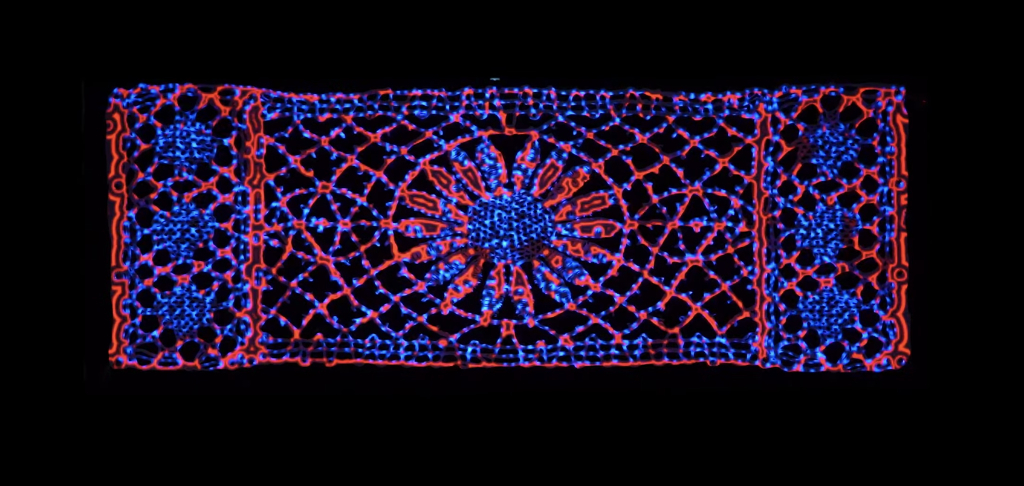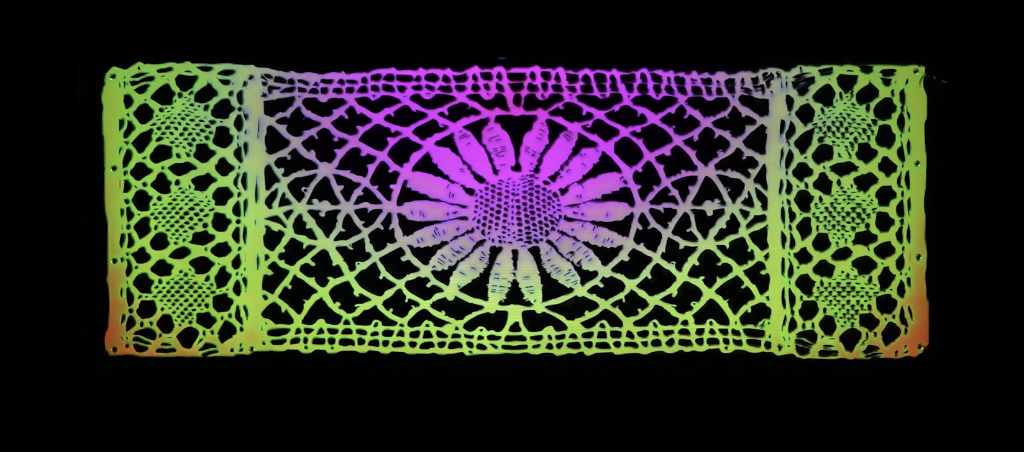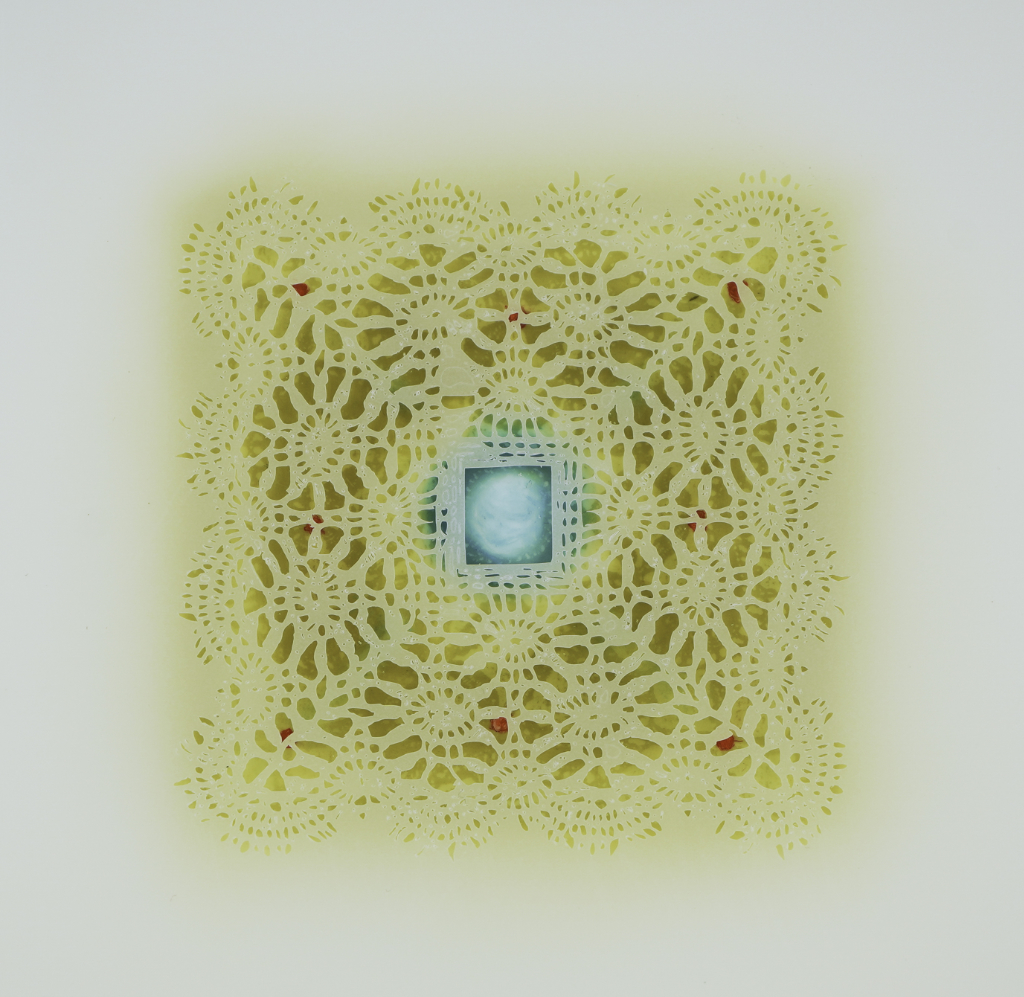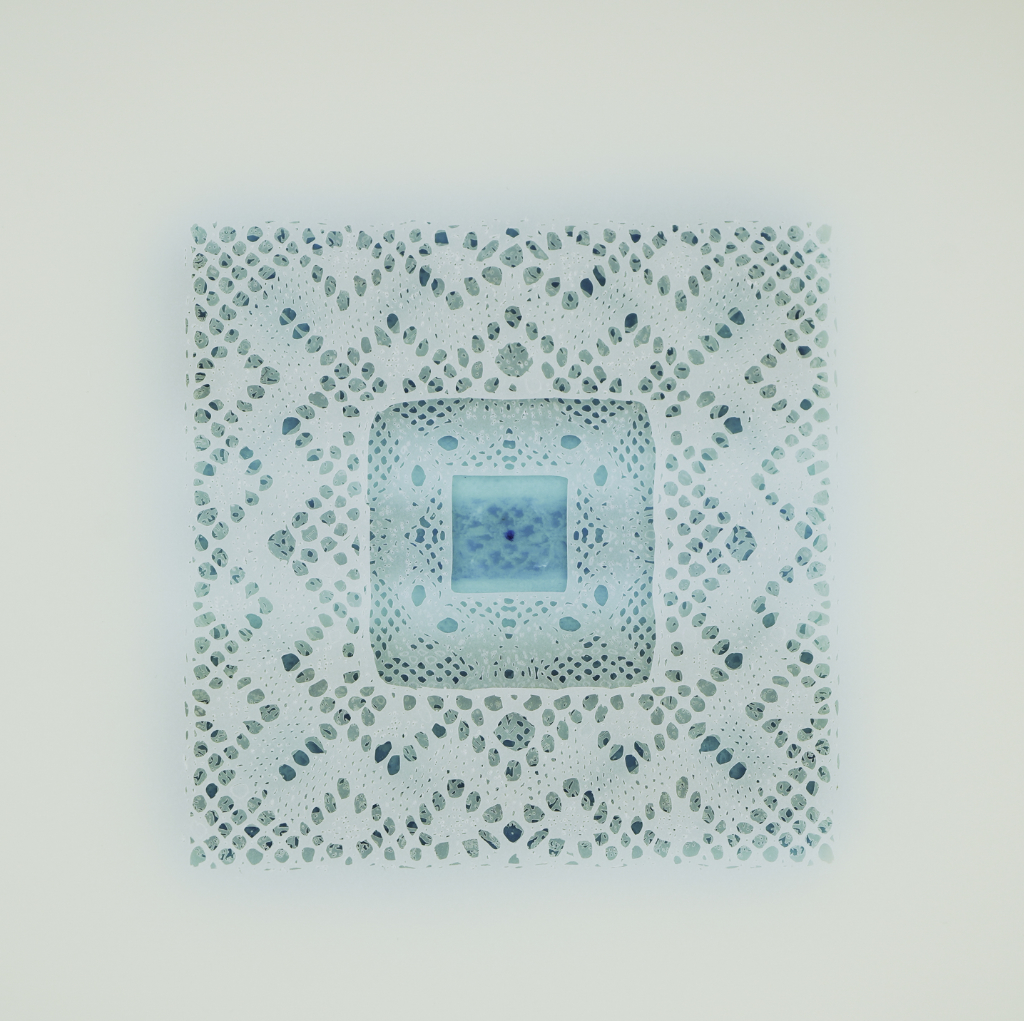Text by Anne Murray

In these turbulent times, Amy Sands’ paper and transparent acrylic works, along with her Bobbin Lace Fence Project – Projection Mapping, bring a sense of quiet contemplation and internalised beauty to the chaotic narratives of our pandemic world. Using a CNC router, more known as an industrial tool, she can cut through polystyrene material, creating lace patterns from the digitised images she has fed into the machine through specialised software.
In this way, her works encompass a series of fresh looks at old mediums, carrying them through the portals of time into the 21st century with the use of digital means connected to industrial tools. With a long-held interest in women’s work as a subject, she takes the patterns from lace samples and transmits them through the digital vortex, highlighting and elevating these traditional lace-making techniques such as bobbin lacemaking. Her ongoing focus on women’s work as inspiration challenges the viewer to step out of the window of perception, which often ignores human participation in craft.
It overturns these preconceptions of craft as low art, especially what one calls women’s work in many societies. Her innovative use of technology allows us to view women’s work of the past with an eye towards the process of digital modes of thinking and perceiving and up to the moment aesthetics. Sands’ current exhibition at the American Swedish Institute, Lace Reimagined, centers around a hidden book of secrets made by hand and carried across the sea by a female Swedish immigrant. The samples of lace within its pages, form a cultural history passed down from one to another of generations of women in Sweden, much like the recipes, we all have treasured and shared in our own families.
Created in a tiny format, these patterns represent a semiotics of traditional designs, where just enough bobbin lace is preserved to recreate, through painstaking analysis, these intricate renderings of each hand movement and entwined production; one might describe it as a conductor’s symphony in the thread. Sands explains its origin, This book, Knyppel Profver, is from the late 1800s. Carolyn Hjelmerus, a Swedish immigrant, created it. After Hjelmerus made these samples in Sweden, she brought the book with her in 1889 when she immigrated to Minneapolis; it was donated to the American Swedish Institute (ASI) by her daughter years later.
Due to the unusual circumstances of the pandemic, Sands was not able to examine and reflect on the institute’s collection directly and relied on correspondence with the Collections Manager at the American Swedish Institute, Inga Theissen. Sands had received an MN State Arts Board Artist Initiative grant for her proposed work in relation to the institute’s textiles collection, which she received in January of 2020. The ASI team was gracious in helping me through this whole process and shared their digital collection online. The book was not online yet, but after I had selected a few other lace-like works from their digital archives, Inga Thiessen thought of this book and shared it with me through some hi-resolution photographs via email. I immediately fell in love with the book and decided to base my whole exhibition on it, Sands extrapolates.





The works produced in her Bobbin Lace acrylic Plexiglas series exemplify these hybrid combinations of historical lace patterns redrawn by hand with her IPad and produced with laser engraving. In the new digitally designed lace patterns Sands created, we see the acrylic sheeting, which is engraved by the laser cutter and displayed upright in the window.
This allows for light to pass through and cast shadows from the acrylic sheeting in a manner reminiscent of the works of the artist Anila Agha, although these patterns come from different cultural roots in Sweden. Her Astra and Constellation series include digitally cut papers which are intuitively placed one over the other in translucent layers until the desired effect is achieved. A hand-coloured underlayer is created first through serigraphy on translucent Dura-Lar film. Upper layers are digitally cut with patterns inspired from the sample book and then placed over each other as muted layers that recall parchment. Their designs appear dreamlike as if they are the iris of a living being with a world of poetry floating within.
Her Bobbin Lace Fence Project is a large-scale CNC cut installation presented on the exterior fence of the institute. As part of the installation concept, Sands produced a projection mapping to have been used for summer outdoor events, which are now cancelled due to the Covid-19 crisis. She produced digital projection mapping using Lightform software and technologies. The result is an elegant combination of low and high-tech integration, which is currently available to be admired on Youtube despite the summer event cancellations.
I wondered how much Sands had uncovered about the details of the lace. The stories that could be told from these pages of history from small hand-made patterns; the book contains various Swedish bobbin lace motifs, including patterns such as ‘sockendal, gingercookie, dukaterna’, meeting hearts and some other patterns influenced by Eastern Europe. Since many of the women of this time worked in isolation or at home, the motifs can be traced to specific villages within Sweden where the lace was created. In this case, the patterns connected with the village of Vadstena, Sweden.
Sands expounds upon this metamorphic process, “The patterns translate differently depending on the tools and materials used. I have always had a fascination with translucent materials. This is present in both the acrylic Plexiglas engravings and the duralar papers used in the framed prints in the exhibition. I often work in layers with my prints, incorporating cut and printed patterns that merge with the material’s translucency. This layering allows for subtle depth and the patterns to dissolve and reemerge – almost like the dynamics of memory.”
The codification of memory becomes entwined in the production of meaning through these works, their beauty and delicate nature captured as if had brought the icy lakes of Sweden with them; the acrylic a glaze which freezes them in time, and ice that captures, illuminates and expands them to a large-as-life scale. The paper works are tiny, close to the size of the original lace patterns, while the acrylic works are corporal, about the size of the body of the woman who made the bobbin lace book; they are a peaceful memory, perhaps a memorial to her even.
I have a number of three-inch miniature works that are wonderful to hold. It becomes an intimate experience with the viewer and the work. I like that they become small treasures and invite the viewer in to observe tiny details. The other extreme is blowing these up so large that they envelop the viewer. This happens in the outdoor installation where the pieces demand attention. I think of it as my way of bringing awareness of these historical patterns and honouring them, Sands explains.
And what might be the future history and impact of her work? I asked Sands, I feel like we are at the cusp of a major resurgence of works made by women that were suppressed because of patriarchal systems that have been in place throughout history. Because the woman’s place was mostly in the home in our collective histories, the works made by women often have a domestic connection. I want to think that my work helps bring these historical creations into the light, whether by these kinds of discussions or through the reimagined vision I have with the patterns in my works. I would love to think of my work being a part of art history, but that is for others to decide. Sands has a studio in Minneapolis and is Associate Professor at Metropolitan State University in St. Paul, MN.






